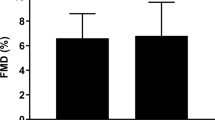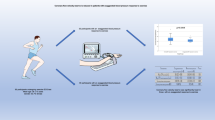Abstract
Cardiovascular mortality has been shown to vary seasonally. However, it has not been determined whether vascular function is affected by the season. The purpose of this study was to investigate the associations of vascular function with season and outdoor temperature. Between April 2007 and March 2022, measurements of flow-mediated vasodilation (FMD) of the brachial artery as an index of endothelial function and nitroglycerine-induced vasodilation (NID) as an index of endothelium-independent vasodilation were performed in 2190 subjects. There was no significant seasonal difference in FMD (spring, 3.9 ± 3.1%; summer, 3.5 ± 3.0%; fall, 3.7 ± 3.0%; winter, 3.6 ± 3.2%; P = 0.14). There was no significant correlation between FMD and daily mean outdoor temperature (r = −0.02, P = 0.25). Multivariate analyses revealed that neither season (β = −0.020, P = 0.31) nor outdoor temperature (β = 0.005, P = 0.81) was significantly associated with FMD after adjustment for other confounding factors. There were significant seasonal differences in NID (spring, 12.8 ± 6.3%; summer, 12.0 ± 6.1%; fall, 11.7 ± 6.1%; winter, 12.3 ± 5.9%; P = 0.02). However, multivariate analysis revealed that there was no significant association between season and NID after adjustment for other confounding factors (β = −0.012, P = 0.56). There was no significant correlation between NID and daily outdoor mean temperature (r = −0.03, P = 0.17). Multivariate analysis revealed that outdoor temperature was not significantly associated with NID (β = −0.006, P = 0.78). There was no significant association of FMD or NID with season or outdoor temperature, suggesting that it is not necessary to take into account the effects of season and outdoor temperature on vascular function when interpreting the results of FMD and NID measurements. Public trials registry number: UMIN000039512.

This is a preview of subscription content, access via your institution
Access options
Subscribe to this journal
Receive 12 print issues and online access
$259.00 per year
only $21.58 per issue
Buy this article
- Purchase on Springer Link
- Instant access to full article PDF
Prices may be subject to local taxes which are calculated during checkout


Similar content being viewed by others
References
Flammer AJ, Anderson T, Celermajer DS, Creager MA, Deanfield J, Ganz P, et al. The assessment of endothelial function: from research into clinical practice. Circulation. 2012;126:753–67.
Maruhashi T, Kihara Y, Higashi Y. Assessment of endothelium-independent vasodilation: from methodology to clinical perspectives. J Hypertens. 2018;36:1460–7.
Adams MR, Robinson J, McCredie R, Seale JP, Sorensen KE, Deanfield JE, et al. Smooth muscle dysfunction occurs independently of impaired endothelium-dependent dilation in adults at risk of atherosclerosis. J Am Coll Cardiol. 1998;32:123–7.
Lerman A, Zeiher AM. Endothelial function: cardiac events. Circulation. 2005;111:363–8.
Matsuzawa Y, Kwon TG, Lennon RJ, Lerman LO, Lerman A. Prognostic value of flow-mediated vasodilation in brachial artery and fingertip artery for cardiovascular events: a systematic review and meta-analysis. J Am Heart Assoc. 2015;4:e002270.
Kajikawa M, Maruhashi T, Hida E, Iwamoto Y, Matsumoto T, Iwamoto A, et al. Combination of flow-mediated vasodilation and nitroglycerine-induced vasodilation is more effective for prediction of cardiovascular events. Hypertension. 2016;67:1045–52.
Akamatsu D, Sato A, Goto H, Watanabe T, Hashimoto M, Shimizu T, et al. Nitroglycerin-mediated vasodilatation of the brachial artery may predict long-term cardiovascular events irrespective of the presence of atherosclerotic disease. J Atheroscler Thromb. 2010;17:1266–74.
Bhatnagar A. Environmental determinants of cardiovascular disease. Circ Res. 2017;121:162–80.
Tanaka H, Shinjo M, Tsukuma H, Kawazuma Y, Shimoji S, Kinoshita N, et al. Seasonal variation in mortality from ischemic heart disease and cerebrovascular disease in Okinawa and Osaka: the possible role of air temperature. J Epidemiol. 2000;10:392–8.
Barnett AG, de Looper M, Fraser JF. The seasonality in heart failure deaths and total cardiovascular deaths. Aust N Z J Public Health. 2008;32:408–13.
Widlansky ME, Vita JA, Keyes MJ, Larson MG, Hamburg NM, Levy D, et al. Relation of season and temperature to endothelium-dependent flow-mediated vasodilation in subjects without clinical evidence of cardiovascular disease (from the Framingham Heart Study). Am J Cardiol. 2007;100:518–23.
Iwata M, Miyashita Y, Kumagai H. Seasonal variation of endothelium-dependent flow-mediated vasodilation measured in the same subjects. Am J Cardiovasc Dis. 2012;2:111–5.
Honda H, Igaki M, Komatsu M, Tanaka SI. Seasonal variations on endothelium-dependent flow-mediated vasodilation in adults with type 2 diabetes and nondiabetic adults with hypertension and/or dyslipidaemia who perform regular exercise. Endocrinol Diabetes Metabol. 2021;4:e00168.
Nawrot TS, Staessen JA, Fagard RH, Van Bortel LM, Struijker-Boudier HA. Endothelial function and outdoor temperature. Eur J Epidemiol. 2005;20:407–10.
Klein-Weigel P, Krall K, Falkensammer J, Heinz-Erian P, Ulmer H, Fraedrich G. Lack of seasonal variation in flow-mediated dilatation of the brachial artery in women with primary Raynaud’s phenomenon and healthy controls. Vasa. 2003;32:69–73.
Umemura S, Arima H, Arima S, Asayama K, Dohi Y, Hirooka Y, et al. The Japanese Society of Hypertension Guidelines for the Management of Hypertension (JSH 2019). Hypertens Res. 2019;42:1235–481.
American Diabetes Association: clinical practice recommendations 1999. Diabetes Care. 1999;22S1–114.
Executive Summary of The Third Report of The National Cholesterol Education Program (NCEP) Expert Panel on Detection, Evaluation, And Treatment of High Blood Cholesterol In Adults (Adult Treatment Panel III). Jama. 2001;285:2486-97.
Matsuo S, Imai E, Horio M, Yasuda Y, Tomita K, Nitta K, et al. Revised equations for estimated GFR from serum creatinine in Japan. Am J Kidney Dis. 2009;53:982–92.
Japan Atherosclerosis Society (JAS) Guidelines for Prevention of Atherosclerotic Cardiovascular Disease 2022. https://www.j-athero.org/jp/wp-content/uploads/publications/pdf/GL2022_s/jas_gl2022_3_230210.pdf
Corretti MC, Anderson TJ, Benjamin EJ, Celermajer D, Charbonneau F, Creager MA, et al. Guidelines for the ultrasound assessment of endothelial-dependent flow-mediated vasodilation of the brachial artery: a report of the International Brachial Artery Reactivity Task Force. J Am Coll Cardiol. 2002;39:257–65.
Inoue T, Matsuoka H, Higashi Y, Ueda S, Sata M, Shimada KE, et al. Flow-mediated vasodilation as a diagnostic modality for vascular failure. Hypertens Res. 2008;31:2105–13.
Thijssen DHJ, Bruno RM, van Mil A, Holder SM, Faita F, Greyling A, et al. Expert consensus and evidence-based recommendations for the assessment of flow-mediated dilation in humans. Eur Heart J. 2019;40:2534–47.
Acknowledgements
We thank Megumi Wakisaka, Miki Kumiji, Ki-ichiro Kawano, and Satoko Michiyama for their excellent secretarial assistance.
Funding
Grant-in-Aid for Scientific Research from the Ministry of Education, Science and Culture of Japan (18590815 and 21590898 to YH) and a Grant in Aid of Japanese Arteriosclerosis Prevention Fund (to YH).
Author information
Authors and Affiliations
Corresponding author
Ethics declarations
Conflict of interest
The authors declares no competing of interests.
Additional information
Publisher’s note Springer Nature remains neutral with regard to jurisdictional claims in published maps and institutional affiliations.
Supplementary information
Rights and permissions
Springer Nature or its licensor (e.g. a society or other partner) holds exclusive rights to this article under a publishing agreement with the author(s) or other rightsholder(s); author self-archiving of the accepted manuscript version of this article is solely governed by the terms of such publishing agreement and applicable law.
About this article
Cite this article
Maruhashi, T., Kajikawa, M., Kishimoto, S. et al. Seasonal variations in endothelium-dependent flow-mediated vasodilation and endothelium-independent nitroglycerine-induced vasodilation. Hypertens Res 47, 910–920 (2024). https://doi.org/10.1038/s41440-023-01504-7
Received:
Revised:
Accepted:
Published:
Issue Date:
DOI: https://doi.org/10.1038/s41440-023-01504-7
Keywords
This article is cited by
-
Salt and seasonal variation research in Asia
Hypertension Research (2024)



